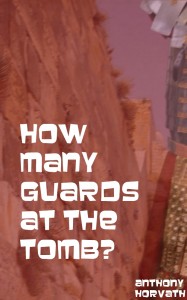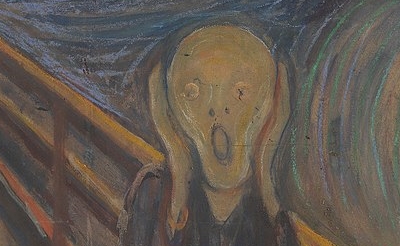 (this is the continuation and the conclusion of a series of essays discussing the number and make-up of the guards at Jesus’ tomb. It can be purchased as an ebook, cover to the right. Main essay | Previous section: Pilate Puts Jesus on Trial, the Jews put Pilate on Trial)
(this is the continuation and the conclusion of a series of essays discussing the number and make-up of the guards at Jesus’ tomb. It can be purchased as an ebook, cover to the right. Main essay | Previous section: Pilate Puts Jesus on Trial, the Jews put Pilate on Trial)
The Presence of Jewish Guards at the Tomb
It has been maintained that both Jewish and Roman guards were present at the tomb. It was shown at length that Roman guards were present, and some evidence presented that describes how Romans went about such work. In my opinion, the arguments already presented encompassed sufficient reasons for believing that men under the service of the elders and chief priests were at the tomb.
To reprise:
1. The Gospel of Peter (70-160 AD) has both Roman soldiers and representatives of the elders and scribes at the tomb throughout the entire event–see verses 9.4 and 10.1. The passage continues to place the Jewish leaders at the scene, having them actually with the centurion, and they themselves personally going to Pilate to ‘smooth things over.’
2. The so-called “Report of Pilate to the Emperor Claudius” explicitly puts both parties together: “…and they crucified him, and when he was buried they set guards upon him. But while my soldiers watched him he rose again on the third day.”
3. The Gospel of Nicodemus/Acts of Pilate (c. 200-350 AD) says, “And while they were still sitting in the synagogue, and wondering about Joseph, there come some of the guard whom the Jews had begged of Pilate to guard the tomb of Jesus, that His disciples might not come and steal Him” and later in the same, “And [the Jews] crucified him, and set guards over him when buried. And he rose again on the third day, while my soldiers were keeping guard.”
All three of these documents explicitly put both Roman and Jewish guards at the scene, and implicitly have them all involved in the affair throughout. I have already argued in the main article that this is implicit in the Gospels, too.
However, it might be said after all this that the Jews did not actually have their own armed men. This can be refuted pretty easily as a general contention, but to keep it in the context of the event under discussion, we will point out that while it may be true they didn’t have their own soldiers, the elders did have their own armed officers, and they did make appearances in Jesus ‘final days.’
When Judas moved to betray Jesus, he led a cohort (‘speira’, so possibly a band of Roman soldiers) and “officers from the chief priests and the Pharisees”, equipped with lanterns, torches and weapons (John 18:3).
The word for ‘officers’ is ‘huparetas’, which according to Thayer’s lexicon, means:
servant an underrower, subordinate rower any one who serves with hands: a servant in the NT of the officers and attendants of magistrates as — of the officer who executes penalties of the attendants of a king, servants, retinue, the soldiers of a king, of the attendant of a synagogue of any one ministering or rendering service any one who aids another in any work an assistant of the preacher of the gospel
Jesus confronts the chief priests and officers, plainly putting weapons in their hands, in Luke 22:52: “Then Jesus said to the priests and officers of the temple and elders who had come against him, ‘Have you come out with swords and clubs as you would against a robber?” See also John 7:32-45 and 18:22
These officers are even present before Pilate, and seem to be among those calling for Jesus’ crucifixion: “So when the chief priests and the officers saw him, they cried out saying, ‘Crucify him! Crucify him!'”
So we see that there is a ready pool of armed men from which the chief priests could draw from right up to the very hours before Jesus’ burial. For reasons already explained, and upon evidence already presented, it is very safe to believe that both Jewish and Roman guards were present at the tomb. This being the case, when Jesus’ body goes missing, despite all these people watching it, one can understand why the argument that the disciples stole the body was seen immediately as ridiculous on its face, and why, when added to everything else, the other view was immediately accepted: Jesus had truly risen from the dead.



Recent Comments